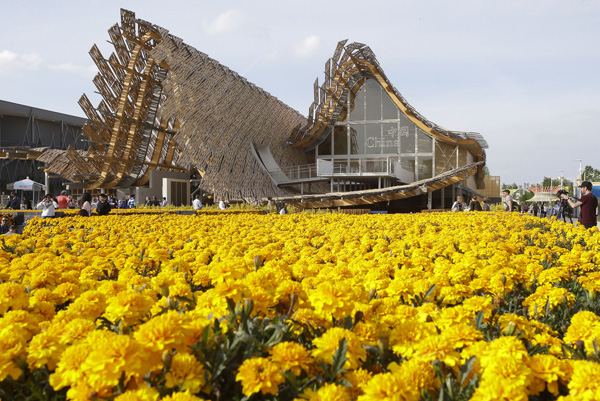|
 |
|
A view of China pavilion at the Expo 2015 in Milan, Italy, Saturday, May 2, 2015. The Expo opened Friday May 1 for a six-month run and its theme is "Feeding the Planet, Energy for Life". [Photo/China Daily] |
Architects use pavilion to paint contemporary image of nation with 'promising future' on international stage
For months, Su Dan has been traveling back and forth between Italy and China, tasked with the monumental job of overseeing the first national pavilion that China has built outside its borders.
The China Pavilion for Milan Expo 2015, which opened on May 1 and ends on Oct 31, is based on the design proposal by the 48-year-old Tsinghua University scholar and his team.
"National pavilions at each world expo are the indicators of the latest development in architecture. They not only showcase one country's prowess in technology but also the evolution of its culture," said Su, the pavilion's design director and vice-dean of the university's Academy of Art and Design.
"In a nutshell, it mirrors one country's image. So it is always a challenge for designers, especially when you design for a country that has a long and rich history and diverse culture."
Many of the national pavilions from the 140 economies participating in the event will likely go for bold designs that aim to impress, a challenge that Su's team of about 30 professors from China's top art and design schools are embracing with a different approach.
Su's theme for the China Pavilion is "The Land of Hope". Embodying this is the building's roof, which is shaped like a cresting ocean wave of opaque glass-like shingles.
Surrounding the pavilion is a field of what looks like 30,000 stalks of wheat-to connect visitors with the Chinese farming culture-that are actually shafts of LED lighting.
Su said the pavilion is a perfect reflection of the Milan Expro's theme: "Feeding the Planet, Energy for Life".
The wheat field functions as an LED multimedia installation to form one of the centerpieces of the building's exhibition program.
"The image we are trying to deliver is rather contemporary," says Su, who won an award in 2012 at Idea-King, a China-based international competition for landscape planning and design.
In Su's opinion, the 2010 Shanghai Expo's China Pavilion, known as "The Oriental Crown" because of its resemblance to an ancient Chinese crown, is an expression of China via a giant symbol, something his team did not go after.
"We want to build an image of modern China, a big country full of energy and a promising future," Su said.
According to Lu Yichen, associate professor at Tsinghua University and the chief architect of the China Pavilion, the team didn't intentionally design an attention-grabbing form.
"We highlighted the experience and quality of the space. For us, this is the most important part of the building," said Lu, who is also the principal of the New York architecture firm Studio Link-Arc, a partner of Tsinghua on designing and building the pavilion.
